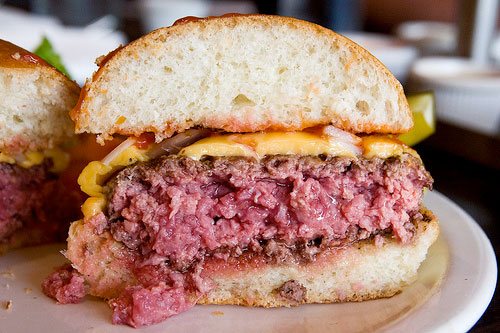Wales has some money issues.
But bacteriologist Professor Hugh Pennington, who chaired a public inquiry into the  South Wales Valleys E. coli O157 outbreak in 2005, which claimed the life of five-year-old Mason Jones, will tell the National Assembly’s health committee this week that public health needs to be spared from expected budget cuts.
South Wales Valleys E. coli O157 outbreak in 2005, which claimed the life of five-year-old Mason Jones, will tell the National Assembly’s health committee this week that public health needs to be spared from expected budget cuts.
He is asking for councils to be given enough money to spare experienced environmental health officers.
Pennington said earlier in the week,
“My immediate concern is that in the implementation of financial reductions by the shedding of staff, policy will be driven by human resource departments rather than the need to retain experience and institutional memory.”
That’s a common theme I’ve heard over the years in trying to figure out why all these foodborne illness outbreaks keep happening, especially in processed foods which should have the poop processed out of them: companies just lack people who know what they’re doing when it comes to food safety.
But I have to take issue with the good professor when he says the 2000 E. coli O157:H7 outbreak in the water supply of Walkerton, Ontario (that’s in Canada) which sickened 2,300 and killed seven was caused because of lax water supply safety checks due to budget cuts.
In his health committee paper Prof Pennington said the event in Canada “provides evidence that rather than maintaining the systems that protected the population from E. coli O157, the Canadian approach to managing budget cuts contributed to the regulatory failures that led to this massive outbreak.”
Budgetary issues may have been a contributing factor, but more money doesn’t mean people will do what they’re supposed to do
The Walkerton Commission of Inquiry, led by Mr. Justice Dennis O’Connor, concluded:
• Seven people died, and more than 2,300 became ill. Some people, particularly children, may endure lasting effects.
• The contaminants, largely E. coli O157:H7 and Campylobacter jejuni, entered the Walkerton system through Well 5 on or shortly after May 12, 2000.
• The primary, if not the only, source of the contamination was manure that had been spread on a farm near Well 5. The owner of this farm followed proper practices and should not be faulted.
• The outbreak would have been prevented by the use of continuous chlorine residual and turbidity monitors at Well 5.
 • The failure to use continuous monitors at Well 5 resulted from short-comings in the approvals and inspections programs of the Ministry of the Environment (MOE). The Walkerton Public Utilities Commission (PUC) operators lacked the training and expertise necessary to identify either the vulnerability of Well 5 to surface contamination or the resulting need for continuous chlorine residual and turbidity monitors.
• The failure to use continuous monitors at Well 5 resulted from short-comings in the approvals and inspections programs of the Ministry of the Environment (MOE). The Walkerton Public Utilities Commission (PUC) operators lacked the training and expertise necessary to identify either the vulnerability of Well 5 to surface contamination or the resulting need for continuous chlorine residual and turbidity monitors.
• The scope of the outbreak would very likely have been substantially reduced if the Walkerton PUC operators had measured chlorine residuals at Well 5 daily, as they should have, during the critical period when contamination was entering the system.
• For years, the PUC operators engaged in a host of improper operating practices, including failing to use adequate doses of chlorine, failing to monitor chlorine residuals daily, making false entries about residuals in daily operating records, and misstating the locations at which microbiological samples were taken. The operators knew that these practices were unacceptable and contrary to MOE guidelines and directives.
• The MOE’s inspections program should have detected the Walkerton PUC’s improper treatment and monitoring practices and ensured that those practices were corrected.
• On Friday, May 19, 2000, and on the days following, the PUC’s general manager concealed from the Bruce-Grey-Owen Sound Health Unit and others the adverse test results from water samples taken on May 15 and the fact that Well 7 had operated without a chlorinator during that week and earlier that month. Had he disclosed either of these facts, the health unit would have issued a boil water advisory on May 19, and 300 to 400 illnesses would have been avoided.
• In responding to the outbreak, the health unit acted diligently and should not be faulted for failing to issue the boil water advisory before Sunday, May 21. However, some residents of Walkerton did not become aware of the boil water advisory on May 21. The advisory should have been more broadly disseminated.
• The provincial government’s budget reductions led to the discontinuation of government laboratory testing services for municipalities in 1996. In implementing this decision, the government should have enacted a regulation mandating that testing laboratories immediately and directly notify both the MOE and the Medical Officer of Health of adverse results. Had the government done this, the boil water .jpg) advisory would have been issued by May 19 at the latest, thereby preventing hundreds of illnesses.
advisory would have been issued by May 19 at the latest, thereby preventing hundreds of illnesses.
Yesterday, Pennington told the Assembly’s health committee the failure of some firms to comply with basic hygiene legislation is “essentially a disgrace.”
“For any business not to be doing what they are legally obliged to, which is having a HACCP plan or something like it, I think it’s essentially a disgrace. I am not yet convinced that we have got to the point where we can say that all small businesses have got a HACCP running which an environmental health officer should be satisfied with.”
Consumer Focus Wales’ Senior Director Maria Battle took a different approach, telling the committee food businesses should be legally required to display their hygiene rating on the premises.
The Food Standards Agency is currently developing the Food Hygiene Ratings Scheme, also known as ‘Scores on the Doors,’ but the scheme only allows for voluntary display. Consumers will have to visit a website to find out about poorly performing businesses.
It’s not Scores on Doors if the results are not publicly displayed. Regulatory, financial, shock and shame, all of these approaches should be explored to enhance the food safety culture of any food business.
 were left lying in food preparation areas.
were left lying in food preparation areas.
.jpg) year-old Mason Jones in the South Wales Valleys.
year-old Mason Jones in the South Wales Valleys..jpg) cooked meat products using separate counters, equipment and staff.
cooked meat products using separate counters, equipment and staff..jpg) cooked meat products using separate counters, equipment and staff.
cooked meat products using separate counters, equipment and staff. Wales Online reports the U.K. Department for Health yesterday said no final decision had been taken about the fate of the FSA, but admitted it was “under review” along with other bodies.
Wales Online reports the U.K. Department for Health yesterday said no final decision had been taken about the fate of the FSA, but admitted it was “under review” along with other bodies. South Wales Valleys E. coli O157 outbreak in 2005, which claimed the life of five-year-old Mason Jones,
South Wales Valleys E. coli O157 outbreak in 2005, which claimed the life of five-year-old Mason Jones, .jpg) advisory would have been issued by May 19 at the latest, thereby preventing hundreds of illnesses.
advisory would have been issued by May 19 at the latest, thereby preventing hundreds of illnesses.  Prof Hugh Pennington, who has chaired two public inquiries into major outbreaks of E. coli O157, said he was concerned about the number of experienced personnel being lost due to budget cuts, adding,
Prof Hugh Pennington, who has chaired two public inquiries into major outbreaks of E. coli O157, said he was concerned about the number of experienced personnel being lost due to budget cuts, adding,
 produced by family butchers John Barr & Son. The Butcher of Scotland, who had been in business for 28 years and who was previously awarded the title of Scottish Butcher of the Year, was using the same knives to handle raw and cooked meat. That’s a food safety no-no.
produced by family butchers John Barr & Son. The Butcher of Scotland, who had been in business for 28 years and who was previously awarded the title of Scottish Butcher of the Year, was using the same knives to handle raw and cooked meat. That’s a food safety no-no. So who allowed Tudor to operate under such conditions?
So who allowed Tudor to operate under such conditions? He said medium-well.
He said medium-well. Y
Y.jpeg)
.jpg) Today, the
Today, the